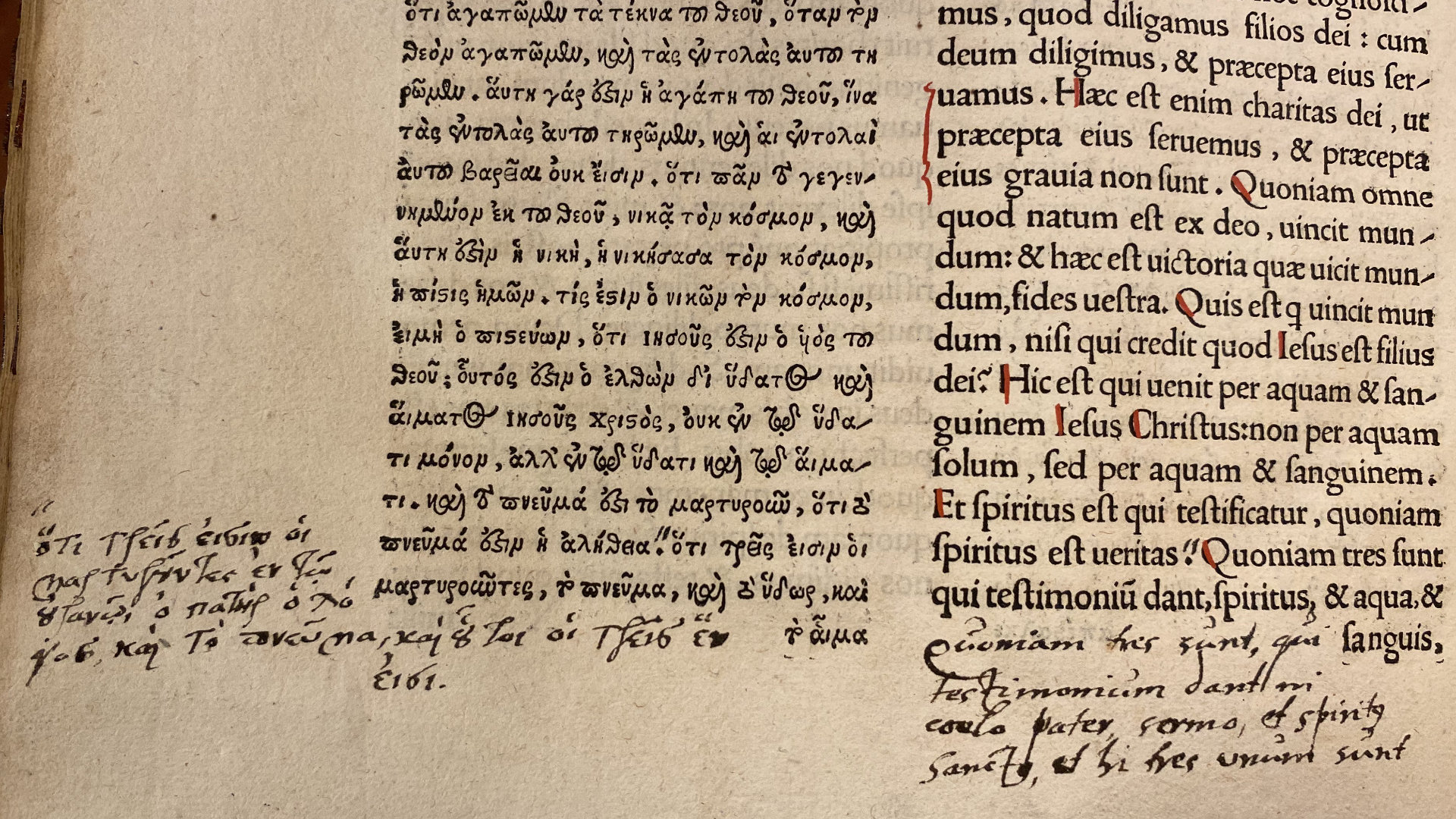For an Informed Love of God
You are here
The Trinitarian Formula in 1 John 5:7–8
One of the ongoing attacks on modern translations has to do with the Trinitarian formula in 1 John 5:7–8. The accusation is that modern translators are dropping out the divinity of Christ from the Bible. I’ve now actually seen the factual evidence of why this is not true.

Both images are copyright, Dunham Bible Museum, used with permission.
It is one of those charges that no matter how many times it is refuted — and it is easy to refute — the charges continue to circulate. I was in the manuscript library at Houston Baptist University this past weekend, the Dunham Bible Museum, and I was actually able to hold a second and third edition of Erasmus’ Greek text, page through it, and take pictures (without flash).
I checked out the longer ending of Mark (16:9–20), the pericope of the Woman Caught in Adultery (John 7:53–8:11, which is the worst name for a pericope in the Bible since the man was caught as well), and then went to 1 John 5 to check out the Comma Johanneum, as it is called. The words in italics below were added centuries after John wrote the epistle. The words are in the footnotes of the NIV, NASB, CSB, NET, and NLT (surprisingly not in the ESV or NRSV) but present in the KJV.
“For there are three that bear record in heaven, the Father, the Word, and the Holy Ghost: and these three are one. And there are three that bear witness in earth, the Spirit, and the water, and the blood: and these three agree in one” (1 John 5:7b–8a).
Thankfully, the doctrine of the Trinity does not depend on these verses; even though most modern translations put them in the footnotes, there are many places in our Bible that plant the seeds of the doctrine of the Trinity. But these verses in 1 John were not written by John, and it would be better to base doctrine on words that we know were written by the New Testament authors.
- The words occur in only eight Greek manuscripts, four in the text and four in the margin. The oldest of these manuscripts is from the tenth century, the others from the fourteenth century and later.
- The Comma Johanneum was not in Erasmus’ first or second edition, nor in the three manuscripts he used to edit his own text.
- They are not quoted by any of the early Greek Fathers until the fifth century, who would have certainly used them in their defense of the Trinity if the words were authentic.
- The words are absent from ancient translations.
- The words first appear in a fourth century Latin treatise, Liber apologeticus.
- They are not present in the Latin used by Tertullian, Cyprian, or Augustine.
- They are not in Jerome’s Latin Vulgate but were added in the ninth century.
So how did these words get into the Bible? Erasmus clearly states that they were not original, but due to church pressure he added them from a suspected forged Greek manuscript in his third edition of the Greek New Testament. This edition was basically the basis for the KJV.
And this takes me back to the Dunham Bible Museum. As you can see from the picture above, somebody wrote the formula into the margin of the second edition, and it was moved into the text of the third edition (see below).

Modern Bibles do not leave the verse out; a few of the Greek texts behind the King James added them in. If it is wrong to subtract from God’s Word (and it is), so also it is wrong to add to God’s word. If we are going to criticize Bible translations, let’s do it accurately, with grace, knowing that all major Bible translations will lead you to the cross, and none will lead you to heresy.


Comments
Thanks for sharing this
Interesting
High View or Low View of Scripture?
Bengel' Comments on 1 John 5:7